CALIFORNIA DOMINATES 2008 TABLOID WITCH AWARDS
by Thomas M. Sipos, managing editor.
[October 9, 2008]
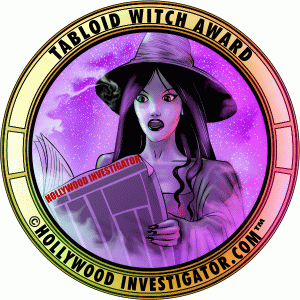 [HollywoodInvestigator.com]..Foreign
films made a strong showing in 2007, and NYU film school students and graduates
were prevalent in 2004 and 2005. But the 2008 Tabloid
Witch Awards horror film contest was dominated by entries from California. [HollywoodInvestigator.com]..Foreign
films made a strong showing in 2007, and NYU film school students and graduates
were prevalent in 2004 and 2005. But the 2008 Tabloid
Witch Awards horror film contest was dominated by entries from California.
Six of ten winners were from
the Golden State. All types of horror were received: live action
and animated, music videos and avant-garde, features and shorts, budgets
big and small, films with and without distribution, films from pros, independents,
and students.
Some winning films were from
experienced professionals, but three were student films, and others had
budgets in the hundreds of dollars.
Filmmakers shouldn't feel
bad if they didn't win. Many good films were passed over. A contest is
competitive. It's not how good your film is, but whether it's better than
some very talented competitors.
The 2008 Premiere Screening
will be held at the Santa Monica Public Library,
with filmmakers participating in a Q&A, on November 15, 2008. The screening
is free and open to the public; no tickets or reservations required. First
come, first seated.
Here now, are the winners
of the 2008 Tabloid Witch Awards.
* Best Horror Feature: 9
Lives of Mara
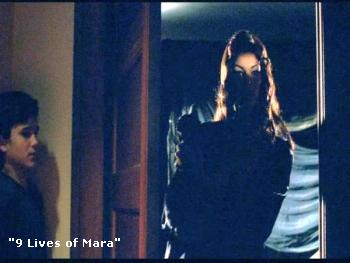 How
could the Tabloid Witch not love 9 Lives of
Mara? The story of a sexy, sinister witch. Or rather, the story of a boy (Robin, played by Bret Loehr) who suspects
his stepmother of being a sexy, sinister witch. But is she? Or is it all
in Robin's head? How
could the Tabloid Witch not love 9 Lives of
Mara? The story of a sexy, sinister witch. Or rather, the story of a boy (Robin, played by Bret Loehr) who suspects
his stepmother of being a sexy, sinister witch. But is she? Or is it all
in Robin's head?
Mara is "supernatural noir" (84 minutes), its tale evoking a blend of Conjure
Wife, H.P.
Lovecraft and Raymond
Chandler.
Ostensibly
set in present day California, 9 Lives of
Mara exists in a retro world of horror comics,
manual typewriters, and smoke-filled offices with linoleum floor tiles
and frosted glass windows. No cell phones, TVs, or computers are evident.
As
influences, director Balaji K. Kumar cites "the early films of Roman
Polanski, and paintings by Caravaggio.and Fuseli.
I love Raymond
Chandler. I think of Mara as
'fairy tale noir.' "
Kumar
and Eric Massey co-wrote the script in a month. "Based on the strength
of
the screenplay, I and co-producer Jina Panebianco raised funds in a few
weeks. Without help from a studio, or rich friends or relatives. Everything
was 100% independent."
A few
scenes were changed for budgetary reasons. "The shooting schedule was 18
days, which gave me very few second takes."
The
cast includes several children and a cat. "It's been a running joke between
Jina and me that we were determined to dispel the old adage of 'never work
with children or animals,' " says Kumar. "We hired a casting director,
and went from there. All were professionals.
"Working
with children left little room for error. I only had them a few hours each
day, in accordance with SAG rules. This
presented obstacles. In one scene, Bret has a conversation with Aspen Payge
[Robin's younger sister.] But I had them on separate days, so neither was
in the room at the same time."
Mara's Raymond
Chandler influence is evident. L.A.'s famous palm trees are visible.
Yet surprisingly, Kumar wanted "a more Midwestern 'This Could Be Anywhere'
look."
Mara was
shot with a Panavision 35mm camera. The documentary footage was shot on
16mm film. "I wanted to stay away from digital," says Kumar, "to give the
movie a timeless feel. And it makes the film more attractive to distributors,
as practically every low-budget independent is digital nowadays. Film still
carries a certain ambiance and look that's impossible to replicate on digital,
although this will change as technology improves."
Kumar
studied cinematography at UCLA and worked as a storyboard artist, which
"helped me be precise with my shot list -- important on a low-budget film."
9 Lives
of Mara is his first feature film. He'd previously
shot a 35mm film trailer for his unproduced script, Twelve
Twisted Tricks, which won for "Best Trailer,
No Movie" at the 4th Golden Trailer Awards.
Co-writer
Massey's marketing background helped in "picking the festivals that would
likely connect with Mara,"
says
Kumar. "The response has been great, which opened the door to distribution."
Mara's
DVD release date is early 2009. Special features include a documentary
on the Malleus
Maleficarum, the book on witchcraft that
the boy uses to investigate his stepmother. "Eric has a deep knowledge
on such esoteric, which really helped in the scripting stage," says Kumar.

* Best Dramatic Horror
Short:.Vadata
A stranger leaves a puzzle piece
outside a writer's door. More pieces follow. The writer never learns who's
leaving the pieces, but foolishly, he completes the puzzle. Whereupon,
a strange and supernatural event occurs...
Vadata.(11
minutes) is a German film, though it isn't evident because its simple tale
has no dialogue. It's what some critics call "pure cinema," relying solely
on visuals and sounds to tell a story. Filmmaker Manuel Lebelt creates
an eerie and menacing atmosphere -- through photography, lighting, art
direction, and sound effects -- that is thick enough to convince viewers
in his tale's malevolent supernatural powers.
Lebelt explains that "Vadata"
comes from "Vadatajs," a type of Latvian
demon. "The Vadatajs make people lose their way, or take the wrong
direction on crossroads, and as they do, their souls lose their way too.
'Vadatajs' means something like 'leading to nowhere,' which is what happens
to the writer in the film.
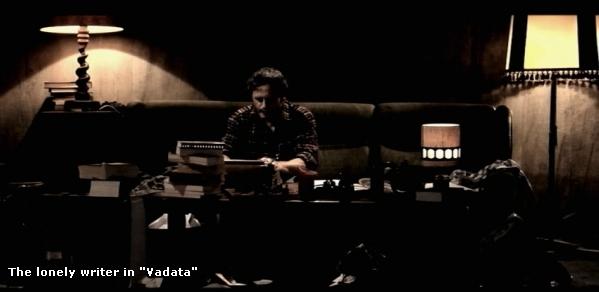
"I wanted to do an old school,
mystery horror kind of thing. To abandon the guts 'n gore of many horror
films. Which doesn't mean I don't like that kind of movie. But there doesn't
have to be a huge, greedy monster, a maniac on the loose, or hordes of
rotten zombies lusting for human brains to have a nice, fantastic plot.
Quiet ways can scare as well. Sometimes even better.
"And I didn't want dialogue.
I wanted to create suspense without direct interaction between actors.
So the lonely writer came about. The spiral staircase is a symbol for infinity,
the central theme in Vadata. The writer seems
to be lonely since the first day of his life, endlessly typing on his old
typewriter. The series of envelopes on his threshold seems to have no end.
The staircase leads further and further. Nobody knows when the 'bad guy,'
dressed clichéd in black, began his evil work, and when he will
end. He simply goes upstairs and upstairs, while his victims go down.
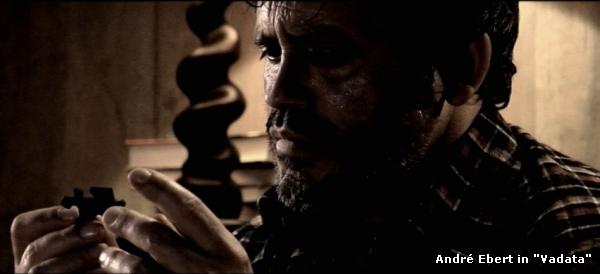
Lebelt cast his film using
German online casting portals. Then his first choice was injured doing
stuntwork on another production, so Lebelt recruited his second pick, André
Ebert. "Retrospectively, André was perfect for the character," says
Lebelt. "I love the closeups of his face. He was very companionable, very
insightful."
Vadata is Lebelt's directorial debut, and his "diploma project" at Offenburg University
of Applied Sciences in Germany. The set for the writer's apartment was
built in a studio at the university. "The spiral staircase was in a castle
ruin," says Lebelt. "It felt like we visited thousands of ruins during
the search. Luckily, the commune granted access and was very accommodating."
Vadata was shot by DP Fabian Zenker on a DVCProHD.
"At college we didn't have access to film cameras," Lebelt explains, "but
we had a Panasonic
HVX200, so we tried the DVCProHD and
the P2
Memory Card. The camera's chip needs much light -- which we
didn't always have -- so some pictures are a bit noisy. Apart from that,
I'm thrilled with what we, and especially Fabian, got out of it.
"Post-production was made
with FinalCutPro.for
editing, After
Effects for the FX, and ProTools for sound design."
Screened at nearly 50 international
film festivals, Vadata won Best Photography
at
Orvietocortofest in Orvieto, Italy. It also won Best Film, Best Photography,
and the Audience Award at Bornshorts in Gudhjem, Denmark. A German pay
TV channel, "13th Street," licensed Vadata for their "Shocking Shorts" film program.
Prof. Dr. Heiner Behring
was Vadata's supervising professor. Lebelt
graduated in 2007. He is an assistant digital colorist at Scanwerk, a post-production
company in Munich. He may be emailed at manuel.lebelt
at gmx.de.

* Best Comedic Horror Short: Cheerbleeders
An unpopular, goth high school
boy gains occult powers over the cheerleaders. He then orders the now rabid
cheerleaders
to attack the football team, then everyone else, so he can take over the
high school. His unpopular, goth girl friend decides that things have gone
too far -- and she must stop him.
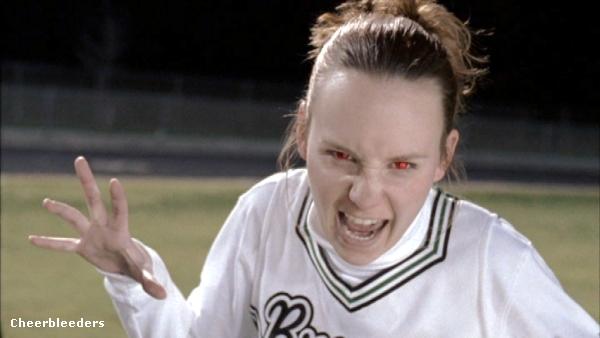
Cheerbleeders rehashes old stereotypes. The smart, bullied, dark-haired goth kids vs.
the blond, bullying football jocks and cheerleaders. Filmmaker Peter Podgursky
admits that Cheerbleeders's has an obvious Heathers.influence,
among many others. Heathers.editor,
Norman Hollyn, was one of his professor's at USC film school, and the two
discussed
the films "Heatherness."
Although a USC student film, Cheerbleeders has professional production values, and is entertaining and funny. The
film was shot on super 16mm film and "finished on HD Cam. The fanciest
piece of gear we used was a doorway dolly." Locations included the USC
campus, Podgursky and a girlfriend's houses, and a football field in Oxnard,
California.
"The big set piece is during
a homecoming football game," says Podgursky. "We drove to my old high school,
and shot a real homecoming game in Blackfoot, Idaho. We brought my actress
with us so we could put her in the crowd shots. Both teams lent me their
football gear for the movie. Then we found a lookalike football field in
Oxnard to shoot at."
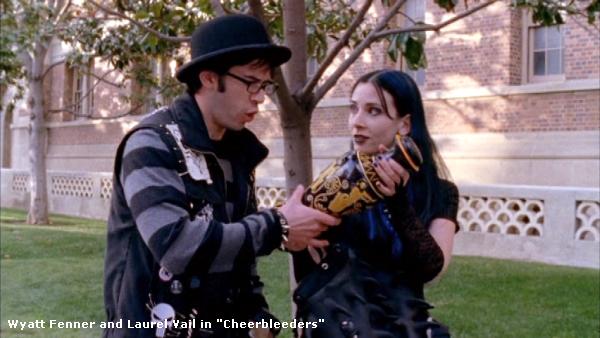
Podgursky wrote the lead
role specifically for Laurel Vail, someone he'd known since age sixteen.
"She went to high school in the next town over. We met through district
drama competitions."
Lead actor Wyatt Fenner appeared
in Podgursky's first short film at USC. "I didn't want to cast him, because
he kind of looks like me. In a lot of student films, the main characters
look like the filmmakers. It's weird. So I auditioned lots of actors that
didn't look like me. Wyatt was friends with a girl I was seeing. She asked
me to audition him. I had no intention of casting him, but he was the first
guy that had the chops. He was in the acting BFA program at USC, a great
program for actors.
"Monique Soltani, who plays
the TV reporter, was a TV reporter in Idaho for a while. She auditioned
for a short I was producing before I made my own thesis. I thought it would
be
really fun for her to play herself in Cheerbleeders."
Podgursky has a BA in theater
from Idaho State University, and now an MFA in film production from USC.
"If you look at the credits of my film, you'll see a list of industry mentors.
These guys and gals are my heroes. I'm so grateful they mentored me. I
don't think Cheerbleeders would have been
nearly as good without their input.
Cheerbleeders has
screened at several film festivals. It won Best Short at the 2008 Phoenix Fear Film Festival.

* Best Animated Horror Short: The
Butterfly Hole
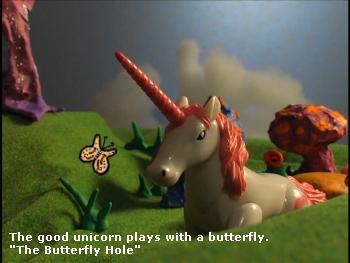 The Tabloid Witch receives so
many animated horror short films, last year we gave it its own category.
This year's winner is the tale of two unicorns. A white unicorn who lives
in the Good Kingdom. And a black unicorn who lives in the Bad Kingdom. The Tabloid Witch receives so
many animated horror short films, last year we gave it its own category.
This year's winner is the tale of two unicorns. A white unicorn who lives
in the Good Kingdom. And a black unicorn who lives in the Bad Kingdom.
The white unicorn plays
and frolics with butterflies. The black unicorn zaps them with his horn,
which shoots a death ray.
One day, these two unicorns
meet.
Filmmaker Joe Fontano says
the idea for The Butterfly Hole (5 minutes)
came when someone gave him two toy unicorns as a present. Those are the
unicorns in the film, which he animated through the stop-motion process.
The
Butterfly Hole is beautifully photographed, with colorful set pieces
representing each kingdom. In addition to the stop-motion unicorns, Fontano
uses other animation techniques to render butterflies, bats, and death
rays.
"I own a Cannon
GL2, which has still photo functions," says Fontano. "I took
roughly 800 pictures to animate together. Other shots, like establishing
shots, are simply two of those images key-framed, one atop the other.
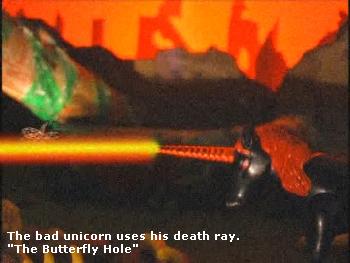 "The stop-motion was mixed
with
something I often do -- I call it 'photoshopmotion' -- for the butterfly
and bats, and so on. I drew the image of the butterfly in Photoshop a few times (each image a different position of the wings) and animated
the simple loop of wings fluttering. I saved it as a separate file, and
brought it into the edit of the final piece, and moved the butterfly around
to interact with the animation waiting for it." "The stop-motion was mixed
with
something I often do -- I call it 'photoshopmotion' -- for the butterfly
and bats, and so on. I drew the image of the butterfly in Photoshop a few times (each image a different position of the wings) and animated
the simple loop of wings fluttering. I saved it as a separate file, and
brought it into the edit of the final piece, and moved the butterfly around
to interact with the animation waiting for it."
The entire film was shot
on a small table in Fontano's living room, in a week's time.
The unicorns never speak,
though they whiny. Two narrators relate the tale, one for each unicorn.
A bubbly Frenchman narrates for the good unicorn. A sinister street thug
for the bad unicorn. When the two unicorns meet for the first time, so
do their narrators.
The two narrators' voices
are strikingly different, and well acted. Remarkably, both narrators are
performed by Fontano.
Fontano recently graduated
from the Art Institute of California, Los
Angeles.
Despite his talent in animation, most of his experience is in video and
filmmaking.
"The
Butterfly Hole was created for a class assignment," Fontano explains.
"We had to tell a story with still pictures. I hate picture stories. It's
like
watching the crew behind Curious
George try to make a movie. I didn't want my assignment to be an album
of
photos, so I just took hundreds of photos, and got carried away with the
project. The teacher thought it was spectacular."
The Tabloid Witch Awards
will be The Butterfly Hole's first public
screening.

* Best Avant-Garde Horror Short: Chemtrails:
An Investigative Report
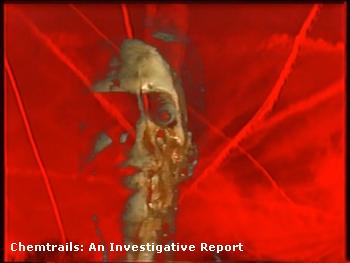 The Tabloid Witch has long celebrated
experimental, underground, avant-garde, and surreal films (or whatever
you want to call them). Honorable Mentions were awarded to Slinky
Milk in 2005 and Moloch in
2006. This year we grant these bizarro "hard to define" films their own
category. The Tabloid Witch has long celebrated
experimental, underground, avant-garde, and surreal films (or whatever
you want to call them). Honorable Mentions were awarded to Slinky
Milk in 2005 and Moloch in
2006. This year we grant these bizarro "hard to define" films their own
category.
Chemtrails:
An Investigative Report (6 minutes) is sort of a mockumentary. It's
hard
to say.
It's also a surreal collage
of arresting images borrowed from the news media and popular films, intercut
with excerpts from talk radio and original footage shot by filmmaker Damon
Packard. The result is a hilarious satire of popular culture, conspiracy
theories, and the war on terror, among other targets.
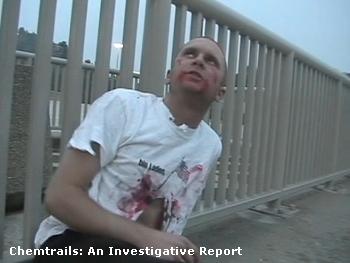 Chemtrails.purports
to be a documentary about chemtrails. Packard dubs footage of an actual
military officer, so that he admits to the government's secret conspiratorial
goal behind chemtrails: to prevent citizens from being able to think independently. Chemtrails.purports
to be a documentary about chemtrails. Packard dubs footage of an actual
military officer, so that he admits to the government's secret conspiratorial
goal behind chemtrails: to prevent citizens from being able to think independently.
These scenes are intercut
with clips from radio's Art Bell Show discussing chemtrails and other conspiracy
stuff, and original footage of people suffering from chemtrails fallout.
An interview for this article
is pending. [The Hollywood Investigator has since interviewed Damon Packard.]
Damon Packard has a MySpace page.

* Best Horror Music Video: Brains
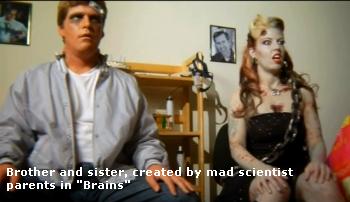 The Tabloid Witch awarded a
Best Horror Music Video to You Make
Me
Feel So Dead in 2004, and since then none. Most "horror" music videos
lack a creative horror element. They're mostly just band members in "shocking"
attire, playing loud music. The Tabloid Witch awarded a
Best Horror Music Video to You Make
Me
Feel So Dead in 2004, and since then none. Most "horror" music videos
lack a creative horror element. They're mostly just band members in "shocking"
attire, playing loud music.
The Shannon Lark directed.Brains is different. It opens with a cute vignette about two teenage "Frankenstein
monster" creatures. They are brother and sister, and they bicker. Their
mad scientist parents scold them. Then the girl stalks out to sing about
her love for brains.
Brains parodies
Liam Sullivan's Kelly Likes Shoes, and is
performed by The Living Dead Girlz,
Lark's horror performance troupe. Unlike many parodies which slavishly
copycat their source, Brains.can
stand on its own creatively and musically. It's also funny (not true of
many parodies), lively, energetic, and sexy (if you don't mind girls covered
in blood, gore, and decaying flesh).
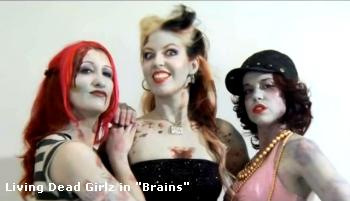 "We were obsessed with Kelly
Likes Shoes," says Lark. "There wasn't a [Living
Dead Girlz] show that went by where we weren't quoting the Shoes video while getting our zombie makeup on. So we took our joy for parodies,
and created one for Shoes. Liam gave us the
rights to the music. We went through each shot and mirrored the video --
but put our own spin on it. "We were obsessed with Kelly
Likes Shoes," says Lark. "There wasn't a [Living
Dead Girlz] show that went by where we weren't quoting the Shoes video while getting our zombie makeup on. So we took our joy for parodies,
and created one for Shoes. Liam gave us the
rights to the music. We went through each shot and mirrored the video --
but put our own spin on it.
"All the people who acted
in Brains were members of the Living
Dead Girlz or friends of the troupe. It was a group process. Amy McDonald
cast the larger parts. Auditions were not held, because we knew who was
perfect for which parts. Amber, the lead singer, is the troupe's director/choreographer.
Jess (with the pink hair) and myself played her best friends. All three
of us carry a good amount of weight for the troupe and making the film.
Jeremy Parsons played the brother. He's a great actor and wonderful to
work with.
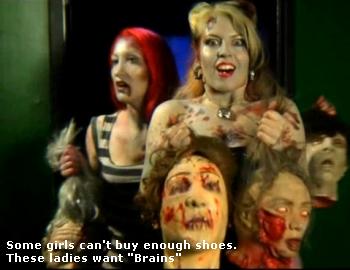 "Jamie Zawinski, owner of
the DNA Lounge, lent us the San Francisco club. Melanie Blau let us use
her pool for the party scene. Amber Steele and Steev Dinkins lent their
apartment. A collection of people chipped in with support." "Jamie Zawinski, owner of
the DNA Lounge, lent us the San Francisco club. Melanie Blau let us use
her pool for the party scene. Amber Steele and Steev Dinkins lent their
apartment. A collection of people chipped in with support."
Dinkins was the DP for Brains,
shot on an HD video camera "with a 35 mm rig over the lens."
Lark has some film school
background, but is mostly self-taught. "I went to the Film Arts Foundation
in San Francisco, doing independent film study. I landed acting roles and
followed crew members around, asking questions. I read books on filmmaking
and taught myself."
Lark founded The
Chainsaw Mafia, a horror filmmakers collective. She manages
the Living Dead Girlz and
the Viscera horror film festival for women.
Brains won 3rd place in the Zombie Apocalypse contest. It played at The Best of Revver, Cathartic 3, and Backseat
Horror Film Festival.

* Honorable Mention
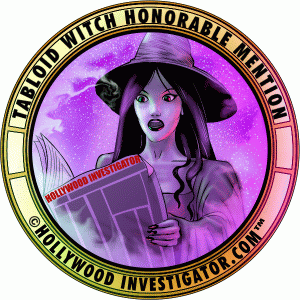 Honorable Mentions are not
easily won. We select fewer films than some other festivals, which run
multiple days, whereas the Tabloid Witch screenings only run one day. Honorable Mentions are not
easily won. We select fewer films than some other festivals, which run
multiple days, whereas the Tabloid Witch screenings only run one day.
Every years, many worthy
films must be turned down.
This means that an Honorable
Mention win is truly something to take pride in. These films topped many
competitors from talented artists to attain the few available spots. These
films are among the cream of contemporary horror.
* 100
Tears
How could the Hollywood Investigator
not love 100
Tears (92 minutes). The story of two heroic tabloid reporters
who save the world. Or at least, two fairly decent tabloid reporters who
try to save central Florida residents from a killer clown.
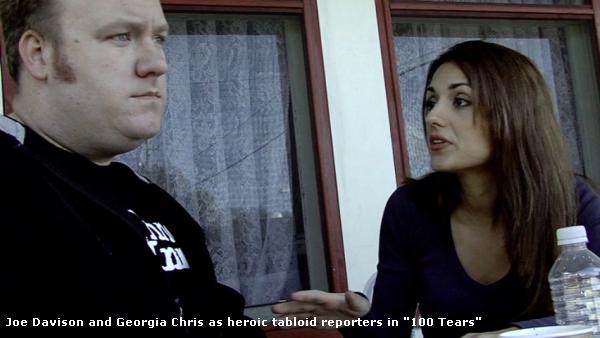
All clowns are evil. But
most are subtle, creepy and menacing, so you can't quite say why they're
evil. Not Gurdy in 100
Tears. He swings a huge meat cleaver -- a HUGE meat cleaver!
-- and racks up a body count faster than you can count his victims.
100
Tears boasts graphic gore and a retro 1970s sensibility, much
like.House
of 1000 Corpses. Writer Joe Davison explains, "My main influence
regarding an overall feel to a horror film is that late 1970s, early 1980's
freshness. Those films were new then. They were amazing. Now we of that
generation are recreating what we saw because it inspired us. Hollywood
isn't remaking anything to just be bastards. The guys running studios now
are the same guys who grew up with those influences. They want to see that
again.
In 2006, Davison and director
Marcus Koch discussed their next project. "I wanted to do a horror action
film titled As Night Falls," says Davison.
"Marcus was keen on his film Babydoll, a dark
comedy about a dead girl. He described a scene about a girl in a room,
tied to a bed, and a clown standing over her. With that I purged 100
Tears in four days.
"I tried to create something
with a plot as well as a blood driven storyline. I wanted Gurdy to be a
clown for a reason. To be sad for a reason. Not just some guy who puts
on clown makeup and kills people. I used devices to fuel him and his anger,
allowing him to be sad, manic, and sociopathic."
Financing came quickly after
the script was finished. "Elmar Berger of Manic Entertainment wanted to
fund a horror film. He'd been talking to Marcus for a while. We sent him
the script. Within a week, we had 90% of our funding."
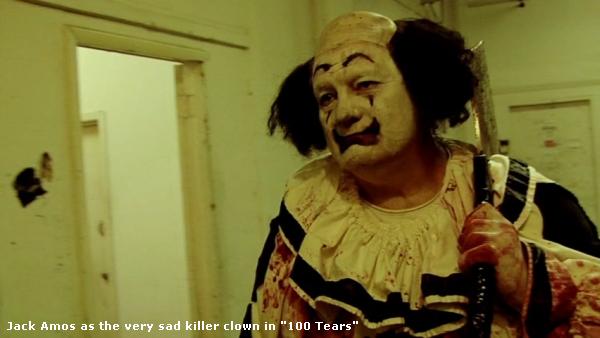
Davison cast himself as the
male tabloid reporter, and Georgia Chris as his partner. "Her character
was the hardest to cast. We must have seen fifty actresses. Then we met
Georgia, who auditioned for another part. Marcus and I knew she was it.
Jack Amos was Gurdy from the get go. I wrote myself the role of Mark, knowing
I could do it. But I still had to prove that to everyone, including myself.
And I'm still a little in the middle on it.
"Raine Brown was offered
to us from Ted Geohagen of Staving Kappa, out of New York. He said, take
a look at Barricade,
by Timo Rose. There's this girl, Raine, you might like. He was right. She
does a fantastic job."
100
Tears was shot in Tampa, and its surrounding areas like Gibsenton.
"We went through the Tampa film office to get one or two locations," says
Davison, "but mostly we just asked the location if we could shoot there.
All said yes."
The film was shot on HD video
using a JVC
110U, which Davison calls "an awesome camera. We used Home Depot
lights, stage lights, and basic gels. If you're shooting indie, and can't
afford a five ton grip truck, Home Depot has what you need."
Davison only has a month
of college under his belt. "I jumped into filmmaking and taught myself.
Back then, shooting on VHS was the in thing. Now you must shoot on HD or
film to get anywhere." He wrote the fantasy novel, Death's
Campaign, and recently returned from Germany, where he starred
Timo Rose's horror film, Beast."
For information see their MySpace
page.

* Mina
It's not easy fitting in at
school when you're a girl werewolf. This is an old horror film conceit,
but Mina (15 minutes) brings its own a stylish
and entertaining take on it.
The film's beautifully photographed,
vibrant, saturated colors, plus a stay-at-home mom and family dinners,
lend a satirically retro, 1950s atmosphere to its gory tale. One thinks
of Ginger
Snaps meets Parents.
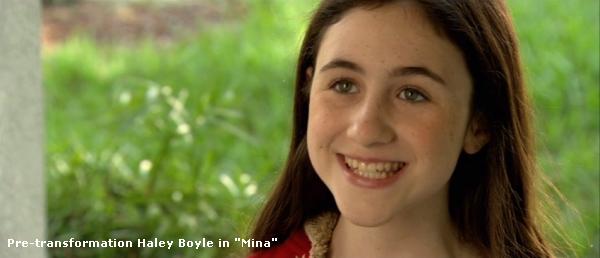
Filmmaker Jose Zambrano Casella
wrote Mina with child actress Haley Boyle
in mind, having worked with Boyle on a previous film. "The rest fell in
place. All the cast were friends of me from past shoots, so not much casting
was needed. The cast was spot on perfect for the characters."
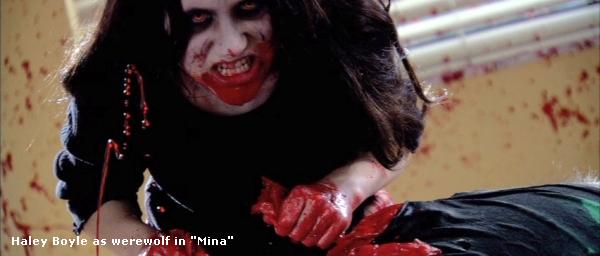
The parents, actress Jessica
Blackmore
in particular, look way too young to parents for a teenager. But I suppose
some werewolves can maintain their youth, sort of like vampires. Their
youth does support Mina's satirical tone.

Using a 720p
HD DV camera, Cassella shot Mina."guerrilla
style" around Orlando, Florida. "We had to shoot fast, as we had no permits,"
he explains.
Remarkably, Mina.was
produced on a $400 budget, yet has the look of a big studio production.
"Shooting in digital, if one applies 35mm techniques, yields great results,"
says Cassella. "We used a shutter speed of 1/1000 second for the blood
scenes, to achieve the 'jittery' look."
Cassella is a professional
cinematographer who only recently began directing. His film proves that
a low budget is no excuse for low production values. Learning one's craft
and talent can overcome lack of money.
To date Mina has won four festivals. "Which is amazing," says Cassella, "considering
the type of film. Most festivals go for the 'real people, real characters'
BS, and give no thought to horror and comedy. We are set to screen in 12
more. We have been very blessed.
"A feature film version of Mina,
a more serious take on the story, already has Crispin Glover and Danny
Trejo attached. So knock on wood. We could start pre-production soon!"
More information may be found
at JoseCassella.com.

* Eel
Girl
Scientists at a top secret government
laboratory observe a creature, who is locked in a chamber. She is part
woman, part eel. When one scientist is called away, the other is left alone
with the female creature. She gives him a come hither look. He responds
by opening the chamber door...

Paul Campion based Eel
Girl (6 minutes) on the song of the same name. "Friends in England
own a record label,.Superglider,
and gave me some albums to hear in 2003. That particular track stuck with
me. When I heard it, I came up with ideas for a music video. A half fish
girl
in a room, watched by scientists. The film was always about that particular
music, with those visual images."
Eel
Girl is no music video. Nor is there really a story at six minutes.
Rather, the film is a "slice of life" vignette about a scientist who unwisely
falls in love with a girl monster. The film ends, leaving us wanting more.
Yet it's beautifully photographed,
its production values and visual effects as slick and professional as anything
coming out of Hollywood's big studios.
Campion calls Eel
Girl "a calling card to getting myself and producer Elisabeth Pinto's
feature film projects off the ground." Those include a film adaptation
of Brian Keene's supernatural thriller, Terminal,
and a film about London criminals and re-animated corpses, called Lore
of the Jungle, written by Paul Finch.
Casting Eel
Girl was relatively easy, aside for the "eel girl," which took more time. "I
wanted someone very beautiful and striking to look at," says Campion, "who'd
retain an element of attractiveness and sexuality under all the prosthetics.
Someone with a slim body type, rather than a voluptuous Playboy type look,
which would probably have been too distracting."
Before he was a director,
Campion illustrated horror book covers. After re-training in computer animation,
he created visual effects for Lord
of the Rings, Constantine, Sin
City, and other major films. He began directing short films a few years
ago, hoping to be hired for features.
Eel
Girl was shot at Weta Workshop. "Richard Taylor kindly let us use
their stage," says Campion. "We spent about four months of weekends building
set
pieces in my garage at home. It took four days to assemble and dress the
set on stage, under the supervision of Mary Pike, the production designer."
Eel
Girl was shot in Campion's native New Zealand, though much of the
production team are British. "We shot on a Panavision Gold Panaflex G2
35mm camera, Ziess prime lenses. Kodak Vision 2 200T 5217 stock. But the
equipment is only as good as the people using it. We were lucky when Richard
Bluck brought his camera, grip and gaffer crews, who previously worked
on Lord
of the Rings and King
Kong."
Campion's film boasts beautiful
cold and bright colors, nearly shimmering. He credits Richard Bluck for
his "beautiful lighting" and that "35mm film gave us the best image quality
possible. A huge range of color depth to play with in the digital intermediate.
We scanned the film at 2K. Joerg Bungert, Weta Digital's in-house colorist,
did the grading in his spare time on a Lustre. One of the main issues was
the difference in color between the eel girl chamber and the observation
room. Joerg spent much time grading the shots where we can see through
the window into both rooms, so we get that beautiful contrast of warm and
cool light."
Eel
Girl won Best Visual Effects Award at A Night of Horror in Sydney,
Australia, and was nominated for many other awards. It screened at Sci-Fi
London, Rhode Island International Film Festival, Fantasia, Montreal, Atlanta
Horror Fest, Pifan, Korea, Fantastic Fest, San Francisco Underground Film
Festival, Screamfest LA, Court Metrange France, among others.
More information at EelGirl.net.and
its MySpace page.

* Creepers
 Aliens invade Earth by possessing
people, turning them into creatures that behave like flesh-eating zombies.
But curiously, they can also look and act "normal" if they want to, so
you don't always know who's an alien, who's human. Sort of like Zombie meets Invasion
of the Body Snatchers. Aliens invade Earth by possessing
people, turning them into creatures that behave like flesh-eating zombies.
But curiously, they can also look and act "normal" if they want to, so
you don't always know who's an alien, who's human. Sort of like Zombie meets Invasion
of the Body Snatchers.
Then two people hide out
in an abandoned house, wondering if the other one is human or ... one of
them!
We don't get enough horror/sci-fi
entries, so it's always nice to get a good one. And Creepers (18
minutes) accomplishes much on a low budget. Its frenetic camerawork and
editing create a sense of panic amid danger. Its murky, greenish hues contribute
to an oppressive atmosphere of claustrophobic paranoia, as though an alien
menace is seeping into the air itself. Additionally, Sarah Ashley and C.J.
Johnson give solid performances as mutually suspicious allies.

We expect to have an interview
with director Nick Thiel shortly.

* Additional Winners
She's smart. She's sassy.
She's tough. And she never lets up. In other words, she's your typical
tabloid reporter.
She's Midnight Star reporter Jennifer Stevenson in 100
Tears. Aka actress Georgia Chris, 2008 Tabloid Witch Awards Best Actress winner. |
 |
 |
Is he a clinically insane,
paranoid schizophrenic? Or is he right that a witch is out to get him?
Chad Donella, as the adult
Robin in 9 Lives of Mara, leaves us open to
either interpretation. Or even both.
His portrayal of a possibly
dangerous, but ultimately sympathetic, mental patient earns him Best
Actor honors. |
If you love psycho babes
(and who doesn't?), you'll love Raine Brown's wonderfully exuberant serial
killer in 100
Tears. Coy and cunning, devious and distraught, she veers from
cloying tears to psychotic rage on the turn of a dime, and you never doubt
her sincerity. She easily wins Best Supporting Actress. |
 |
 |
Maybe someday we'll create
a young actor award. For now, they compete on an equal basis with adults.
Last year a youth won Best Actress. This year Troy Gentile wins Best
Supporting Actor.
As the rotund, foul-mouthed,
cigarette smoking adolescent in 9 Lives of Mara,
Gentile evokes a young Louie
De Palma, with shades of Ralph
Cramden and Oscar
Madison. He is 9 Lives of Mara's most
memorable character. |
We saw many beautiful and
powerful images this year, but only the best can win. Best Cinematography.goes
to 9 Lives of Mara's Joseph Rubinstein.
His arresting visuals contribute
much to the film's supernatural noir atmosphere. Rubinstein shows us the
world through Robin's eyes, so that the boy's irrational fears about witchcraft
seem not only plausible, but very likely true. |
 |
 |
Many entries had slick sound
recording
and mixing. But Vadata has no dialogue, so
that every noise, from a ticking clock to outside street traffic, is an
integral part of the story. As with Rubinstein's images, Lebelt's sound
effects build up to an atmosphere of impending and inevitable supernatural
doom. Manuel Lebelt wins Best Sound for Vadata. |
We don't want to give away
the ending to Eel Girl, but it's pretty unsettling
and creepy. And masterfully rendered on CGI.
Visual Effects Supervisor
Matt Holland wins Best Visual Effects for Eel
Girl. |
 |
 |
Director Marcus Koch's background
is in makeup effects, and it shows. 100
Tears is a bloodbath of grisly gore and viscera. Split skulls
and spilled entrails, hacked heads and severed limbs erupt across the screen.
A delightful return to 1970s indie, drive-in horror, earning Marcus Koch Best Make-Up Effects. |
Psychos and zombies can
get by on gore, but good supernatural horror requires atmosphere.
Cinematography and lighting contribute much to that atmosphere. So does
music.
B. Kumar Ganesh's spooky,
eerie, at times almost religious, music infuses 9
Lives of Mara with undercurrents of mystery, suspense, and supernatural
foreboding, winning him Best Music Soundtrack. |
 |
* The Final Tally
Tabloid Witch
Award Winners
|

|
*
Best Horror Feature Film ........................... Balaji K. Kumar
& Eric Massey (9 Lives of Mara)
* Best Dramatic Horror
Short Film ............... Manuel Lebelt (Vadata)
* Best Comedic Horror Short
Film ............... Peter Podgursky (Cheerbleeders)
* Best Animated Horror
Short Film .............. Joe Fontano (The
Butterfly Hole)
* Best Avant-Garde Horror
Short Film .......... Damon Packard (Chemtrails:
An Investigative Report)
* Best Horror Music Video
............................ Shannon Lark (Brains)
*
Best Actress ............................................... Georgia
Chris (100 Tears)
* Best Actor ..................................................
Chad Donella (9 Lives of Mara)
* Best Supporting Actress
........................... Raine Brown (100
Tears)
* Best Supporting Actor
..............................
Troy Gentile (9 Lives of Mara)
* Best Cinematography
............................... Joseph Rubinstein (9 Lives
of Mara)
* Best Sound ...............................................
Manuel Lebelt (Vadata)
* Best Visual Effects
.................................... Matt Holland (Eel Girl)
* Best Make-Up Effects
................................ Marcus Koch (100
Tears)
* Best Music Soundtrack
............................ Ganesh Kumar (9 Lives of
Mara)
Tabloid Witch
Honorable Mentions
|
 |
* Marcus Koch & Joe
Davison (100
Tears)
* Jose Zambrano Cassella
(Mina)
* Paul Campion (Eel
Girl)
* Nick Thiel & C.J.
Johnson (Creepers)

Copyright 2008 by HollywoodInvestigator.com
|
